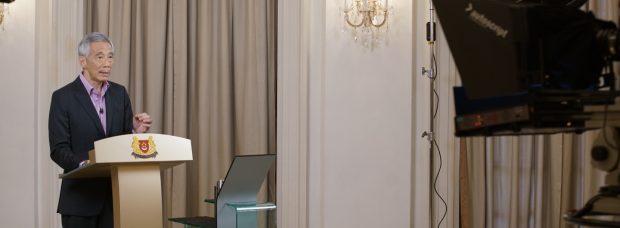
Learn to live with covid-19 in our midst, Singapore PM Lee warns

By Ivan Lim
Former AJA President, Contributor to AsiaN
SINGAPORE: Get ready to live dangerously with the Novel Coronavirus in your midst — this is the new normal into which you have to transit.
Prime Minister Lee Hsien Loong, seeking to drive home the stark reality to all Singaporeans, warned this would be the long-term way of life even though the Republic is making some headway in tackling a new, more contagious B16172 strain that originated in India and is spurring a spike in Covid-19 outbreaks in the community.
Under a ‘heightened alert’ regime, the authorities had imposed a slew of restrictions, such as capping at two the number of people meeting or visiting, plus no dining in, only take-aways, that are beginning to take their toll on businesses and causing unease among residents.
Even with a new package of financial hand-outs, the pressure from the ground has led the government to review its fire-fighting approach of keeping the community covid-free.
Giving an update on the Republic’s efforts in controlling the pandemic, Mr Lee told the nation in a TV broadcast on May 31:
“Even as we tackle our Covid-19 situation, the pandemic rages on around us. Many countries are still not able to bring it under control. One day the global pandemic would subside but I do not expect Covid-19 to disappear.’’
Instead, the virus will linger, continue to circulate in pockets of the global population for years to come.
“This also means we will see small outbreaks of the disease in Singapore from time to time.’’
Some unfavourable feedback from the grassroots suggested that the government had done too little, too late, to plug the loopholes in its open-door policy, thereby allowing travellers from high-rise countries like India to bring in the more infectious mutant variants.
The government appeared to be offering a counter-narrative, arguing that an open borders policy is critical to the island-nation’s economy. Further, there is no fool-proof way to shut out the virus totally.
As at the height of the pandemic in mid-2019, the government has been banking on the success of its stringent protocol of testing and contact-tracing of Covid-19 cases to screen and isolate foreign carriers slipping through.
But the year-long experience of both keeping virus outbreaks low and pump-priming the economy no longer appeared sustainable as the virus shows no sign of petering out.
“In this new normal, Singaporeans will have to learn how to carry on with our lives even with the virus in our midst,” said Mr Lee.
In looking forward to life without masks, the authorities have to raise the game in the battle against the rise of more potent virus mutants.
He then outlined a three-prong strategy to reach the goal.
One, people must be prepared for regular Covid-19 tests, including Do-It-Yourself kits,to pre-empt sudden outbreaks.
Two, intensify COVID-19 cases contact-tracing to identify and isolate individuals quickly;
Three, step up vaccinations to reach a higher proportion of the population.
The aim is to vaccinate at least 70 per cent of the population of 5.7 million and achieve herd immunity, a state when the community becomes immune to the virus as a result of the vaccinations of a majority of the population.
Even so, some infected persons could slip through the safety nets from time to time (and thereby infect others)
“But as long as our population is mostly vaccinated, we should be able to trace, isolate and treat the cases that pop up, and prevent a severe and disastrous outbreak.’
Observers noted that the government is putting in place such counter-measures in order to create a low-Covid-19 environment for rebooting an economy that has been dragged into the doldrums by the pandemic.
In the new setting, the government is counting on getting at least 70 per cent of the 5.7 million population vaccinated to achieve herd immunity.
With a high proportion of the population vaccinated, the risk of the virus transmitting in the community will be minimal.
Infectious disease expert Dr Paul Tambyah reckoned a 80 per cent vaccination rate would do the trick, given Singapore’s global connections and it reliance on foreign workers.
Singapore has still some way to go before it reaches community immunity. The vaccination programme, which began on 30 Dec last year, has seen up to 2.28 million residents given one dose of the Pfizer BioNTech and Moderna vaccines while 1.8 million completed the required two doses.
A concerted drive is now on to get more seniors, middle-aged and children vaccinated before National Day on Aug 9. As many as 280,000 of those in their 60s have yet to take their jabs.
As Professor Tambyah, who is also a senior medical consultant at the National University of Singapore, put it: Singapore “ultimately should aim to have zero deaths, zero severe infections and zero large outbreaks — rather than to have zero Covid-19.”
For the long-term, Singaporeans may find having booster vaccinations against Covid-19 is as common as the flu jabs.
For the moment, however, Singaporeans, whether young or old, are focused on how to go through the stressful one-month (May 14 to June 13) partial lockdown and get back to normal –life, old or new.


